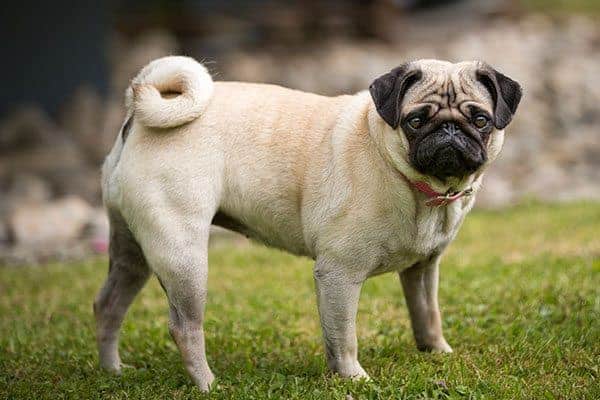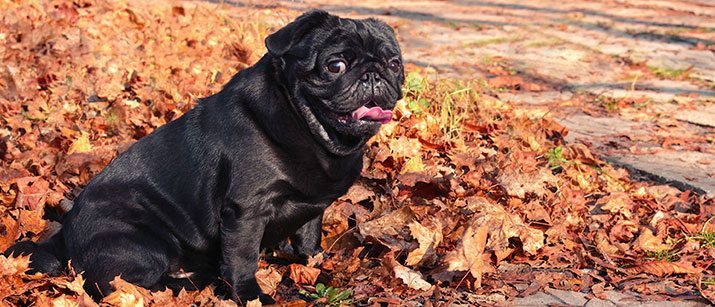What to Know Before Adopting a Pug Puppy
Once a pug owner, always a pug owner. These roly-poly balls of fun are playful, stubborn and fit in beautifully with family life.
Pugs are gorgeous puppies and wonderful adults who are ideal in multi-pet households. Their stocky build means they are sturdy enough even for toddlers and their fun-loving, easy-going nature means they are extremely unlikely to ever bite. They are cheeky, mischievous little clowns who love to play.
Pugs can be determined little dogs who will rule the household if no boundaries are set. They are prone to a number of health problems, so a big budget is suggested and you will need to plan regular vet visits for preventative care. They should be avoided in hot climates, particularly the black variety, as they are prone to heatstroke.
There is a reason why pug owners often end up owning several generations of pugs. These vivacious little dogs have a joyful, adventurous personality and lots of love to give.
WHAT DOES THE PUG WANT IN THEIR PERFECT LIFE PARTNER/FAMILY?
I love a family who can spend time with me, but I’m also happy with the company of another dog, just don’t leave me alone all day! I don’t need much in the way of exercise, so I would suit an elderly person or a family with young kids. If you love cuddles, long evenings on the couch and love to watch me clown around, perhaps you are the perfect owner for me.
AT A GLANCE
| Lifespan | 10-12 years |
| Weight | 6-8 kg (13-18 lb) |
| Height (at shoulder) | 25-28 cm (10-11 in) |
PERSONALITY
Playful – Life is just a game to your average Pug. They love chase, ball-games and playing with other dogs. As they get older they can become a little lazy, but if kept at a healthy weight will often stay playful into middle age.
Stubborn/strong-willed – Pugs are known to be a little stubborn at times. They can be easily trained if motivated and only positive training methods are used, but they will often have a mind of their own.
EXERCISE & TRAINING
| Exercise Requirements | Low – 0-0.5hrs per day |
| Training Requirements | Low – 0-0.5hrs per day |
| Apartment Friendly? | Yes |
Pugs don’t need a great deal of vigorous exercise and in fact given their propensity towards breathing difficulties and overheating they often cannot be walked during the day in hot climates.
They do need strict ground rules and boundaries, and will often have selective hearing when it comes to commands, but Pugs are just as trainable as other dogs. They love their food, so this makes them easy to motivate to learn tricks.
Pugs are happy in an apartment and don’t need a lot of space. They should always have access to shade if kept in a backyard.
GROOMING
| Trips to the Groomer | No- easy care at home | |
| Tick Friendly? | Yes | |
| Hypoallergenic | No | |
| Brushing | Low – Little to now brushing | |
| Hair fall | Moderate Shed- will drop some hair, but not excessive | |
| Coat Type | Short |
Pugs are very low maintenance in the grooming department, but can be prone to allergies and skin disease, particularly in the facial skin folds and in their small, folded ears. If prone to allergies your vet may recommend fatty acid supplementation and weekly oatmeal shampoos, regular ear cleaning and antifungal treatments if yeast are a problem in those skin folds.
FAMILY SITUATION
| Good With Kids | Excellent – Good with kids of any age | |
| Good With Other Small Pets | High – Good with other animals | |
| Sociability | High – Loves other dogs and best in a multi-dog household. |
Pugs love people, other dogs, cats, everyone really. It would be hard to find an aggressive pug, but the same rules apply with early socialization prior to 12 weeks, as with any dog.
They are a small stocky dog, so find with kids of all ages. They are not that discerning in who they make friends with, so will happily cohabit with small creatures and don’t have a high prey drive. They should be supervised around ferrets and rabbits, but are fairly gentle and less likely to chase than most dogs.
EXPENSES
| Overall Expenses (Annual) | Medium – $1500-$2000 | |
| Veterinary Expenses (Annual) | High – $300-$500+ | |
| Food Expenses (Weekly) | Low (toy and small) – $5-$10 |
Pugs can end up with a number of chronic health problems that could land you in the vet clinic more than you may like. Some of these are listed below, but it is worth mentioning that there are many conditions such as Pug Dog Encephalitis, Hip Dysplasia and Demodectic Mange that also crop up quite frequently.
It would certainly be worthwhile looking into pet insurance and checking what the exclusions are to ensure you will be covered for particularly common things like brachycephalic airway disease, eye problems and dental disease.
At least feeding your pug will not break the bank, but you will need to budget for bones and chews to keep those teeth healthy.
HEALTH & WELLBEING
MAJOR HEALTH CONCERNS
Brachycephalic Airway Disease – this syndrome is a result of that shortened, pushed-in nose and wide face. Narrow nostrils, a long soft palate and often a weak trachea all mean that Pugs often have exercise intolerance and are prone to heat stress. Avoiding weight gain and exercise in the heat of the day is important, but some do so much better with surgery. In some cases surgery can be done at the same time as desexing to firstly just widen the nostrils a little, which may be enough to reduce secondary breathing problems as they age.
Ear problems/skin disease – pugs can be prone to allergies, skin infections (particularly in those skin folds), ear infections and anal gland problems, often the whole package occurs due to an allergic condition called atopic dermatitis. In some cases the skin folds are so problematic that surgery (a facelift) is required to resolve eye and chronic skin infections.
Dental disease – Small breed dogs often get significant dental disease, sometimes through poor diet and lack of chewing, but also simply due to genetic factors. Implementing daily brushing, diets that involve chewing and perhaps water additives can help. Pugs are also cursed with poorly aligned teeth, which would need braces in humans. Their teeth may even sit perpendicular to their normal position, so chewing may not be all you need to do to keep your Pug’s teeth clean.
Eye problems – pugs are prone to a disease called Dry Eye where they produce abnormal tears, this means they may need medications for life and may end up with scarring on the cornea, ulceration and chronic infections. They are also prone to developing entropion, or rolled in eyelids, causing the eyelashes to irritate the eye and in some cases cause painful corneal ulcers and vision loss. The condition is easily corrected with surgery. Pugs, having eyes right on the front of their faces, with shallow eye sockets are also prone to ulcerations and trauma and should not be walked with a collar or choke chain due to risk of eye prolapse.
PREVENTATIVE CARE & WHAT TO LOOK FOR:
Eyes – watch for excessive weeping, squinting or dark discolouration on the surface of the eyes. Any signs of eye problems should be checked immediately by your vet. A ‘wait and see’ approach is not a good idea with eye problems. Avoid using a collar or choke chain to walk your pug, due to risk of the eyes popping out of their shallow sockets.
Skin – if your pug licks his feet, has smelly ears or is itchy, ask your vet to check him for allergies. You may need to put him on a special diet, allergy test him or perhaps even use a combination of therapies to get some relief. Often dogs with atopic dermatitis will scoot their bottoms along the carpet, making it seem like they have worms, the problem is actually due to anal gland impaction.
Heatstroke and breathing problems – make sure your pug does not gain excessive weight, as this can make any breathing problems much worse. It also puts your little roly-poly friend at more risk of heat stroke. Dogs don’t sweat like humans, so predominantly rely on panting to cool down, and a short-nosed dog like a pug is much less efficient. If your dog is panting excessively and is making funny noises breathing cool him down by wetting him and putting a fan on him and get him to the vet immediately. Walk your pug with a harness to avoid excessive pressure on the trachea.
BREED ORIGIN AND INTERESTING FACTS
Pugs have uncertain origins, but most agree that they were brought to Europe in the 16th Century by Dust East India Company traders. It is likely that they originated from China and are probably closely related to the Pekinese and Shih Tzu. They were popular among royalty in The Netherlands, England, Spain and Italy.
Pugs have featured in many artistic works from the 16th Century onwards, with earlier depictions showing dogs with longer snouts than the present day pug. It is thought that the pug was also bred with King Charles Spaniels, which is why they have some similarities.
The meaning of ‘Pug’ is disputed, with one meaning indicating the word means ‘monkey’, possibly referring to that monkey-like face (and personality). The alternate meaning is of something that is greatly loved. It is possible that just as is now, pug owners love their little dogs and will often not own another breed after experiencing their adorable, fun-loving natures.
The pug is right up there on the list of the worst roommates, due to their propensity for loud snoring and snuffling. However most pug owners forgive them for these noisy sleep habits!
RESCUE A PUG
Petfinder lists all types of dogs who need homes, both purebred and mixed breeds, adults and puppies.
The ASPCA often has Pugs for adoption, just do an advanced search on their adoption page.
The post What to Know Before Adopting a Pug Puppy appeared first on VetBabble.






Post a Comment